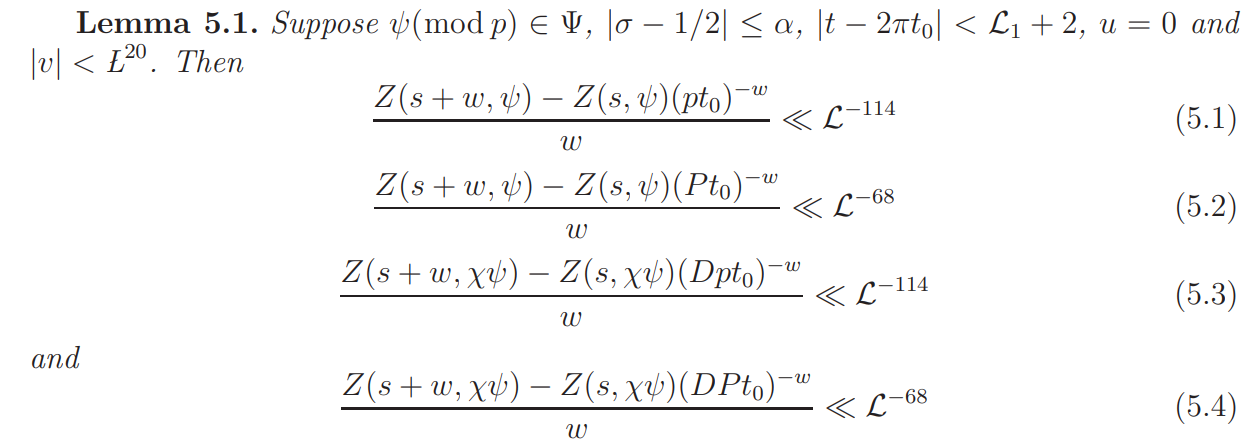Understanding the Role of Analytic Lemmas in Dirichlet L-Functions

:::info
Author:
(1) Yitang Zhang.
:::
Table of Links
Abstract & Introduction
Notation and outline of the proof
The set Ψ1
Zeros of L(s, ψ)L(s, χψ) in Ω
Some analytic lemmas
Approximate formula for L(s, ψ)
Mean value formula I
Evaluation of Ξ11
Evaluation of Ξ12
Proof of Proposition 2.4
Proof of Proposition 2.6
Evaluation of Ξ15
Approximation to Ξ14
Mean value formula II
Evaluation of Φ1
Evaluation of Φ2
Evaluation of Φ3
Proof of Proposition 2.5
Appendix A. Some Euler products
Appendix B. Some arithmetic sums
References
5. Some analytic lemmas
\
\
The proofs of (5.3) and (5.4) are similar.
\
Lemma 5.2. Let ψ and s be as in Lemma 5.1. Then
\
\
Proof. The left side is
\
\
By (2.6) and the Stirling formula, for |w| < 5α,
\
\
Hence, for 1 ≤ j ≤ 3,
\
\
The result now follows since
\
\
Recall that ϑ(s) and ω(s) are given by (2.3) and (2.15) respectively. It is known that
\
\
For t > 1 we have
\
\
where
\
\
Let
\
\
and
\
\
Note that
\
\
\
Proof. By the Mellin transform (see [1], Lemma 2) we have
\
\
\
with
\
\
By the relation
\
\
and Cauchy’s theorem, the proof of (5.8) is reduced to showing that
\
\
for 1 ≤ j ≤ 5, where Lj denote the segments
\
\
\
This yields (5.12) with j = 3 .
\
As a consequence of Lemma 5.3, the Mellin transform
\
\
is analytic for σ > 0.
\
Lemma 5.4. (i). If 1/2 ≤ σ ≤ 2, then
\
\
(ii). If |s − 1| < 10α, then
\
\
Proof. (i). Using partial integration twice we obtain
\
\
By (5.10) we have
\
\
Thus some upper bounds for ∆′′(x) analogous to Lemma 5.3 can be obtained, and (i) follows.
\
\
Throughout the rest of this paper we assume that (A) holds. This assumption will not be repeated in the statements of the lemmas and propositions in the sequel.
\
The next two lemmas are weaker forms of the Deuring-Heillbronn Phenomenon.
\
\
\
Lemma 5.7. We have
\
\
Proof. The right side of the equality
\
\
Lemma 5.8. If
\
\
then
\
\
where
\
\
Proof. This follows from the relation
\
\
\
(A) and a simple bound for L ′′(w, χ).
\
\
Proof. It is known that
\
\
\
\
so that
\
\
By (9.1) and the condition |s − ρ| ≫ α for any ρ,
\
\
so that
\
\
Further, by (5.16) and Proposition 2.2 (iii),
\
\
Combining theses estimates we obtain the result. In the case σ < 1/2 the proof is analogous.
\
\
:::info
This paper is available on arxiv under CC 4.0 license.
:::
\
Welcome to Billionaire Club Co LLC, your gateway to a brand-new social media experience! Sign up today and dive into over 10,000 fresh daily articles and videos curated just for your enjoyment. Enjoy the ad free experience, unlimited content interactions, and get that coveted blue check verification—all for just $1 a month!
Account Frozen
Your account is frozen. You can still view content but cannot interact with it.
Please go to your settings to update your account status.
Open Profile Settings